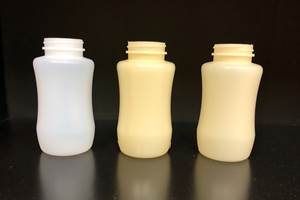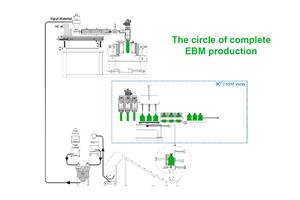Customization is Key to Igniting New Growth in Rigid Plastics Packaging
Frost & Sullivan's rigid plastics packaging study sees focus on innovation and customization as key to future growth.
For the last several years, I have reported on the progress and advantages of flexible packaging innovations that certainly have been making a significant impact, particularly in the food sector and most often at the expense of rigid plastics packaging. Still, rigid packaging is here to stay and with a focus on innovation and customization, will continue to grow. This, according to a new study from global consultancy Frost & Sullivan (U.S. office in San Antonio, Texas). Global Rigid Plastic Packaging Market, Forecast to 2022, identifies market and technology trends; drivers and restraints; market share and competitive analysis.
Prateeksha Kaul, research analyst, Frost & Sullivan, notes that while plastics have delivered many benefits, the environmental impacts associated with their production and disposal have caused serious concerns. “The market is also affected by the presence of competitive packaging options, such as flexible plastic packaging. To mitigate these risks, players will need to develop innovative packaging that conforms to current recycling and re-usability regulations but also to increasingly stringent future environmental regulations.”
Over the past few years, the global rigid packaging market has witnessed steady growth due to rapid urbanization, rising plastic production, technology developments driving smart rigid packaging, and increased application in end-use industries that include food & beverage, pharmaceuticals, personal care & cosmetics. The market is positively impacted by cumulative factors such as increasing population size, changing customer preferences, eating habits and surge in working population. Frost & Sullivan forecasts the market to reach $166.63 billion by 2022, growing at a CAGR of 5.2% between 2017 and 2022.
“To tackle the issue of food safety, food & beverage manufacturers are developing efficient smart packaging systems that will ensure safe food supply and long-term storage, thereby extending a product’s shelf life. They are also developing game-changing technologies such as inert barrier, which eliminates numerous manufacturing processes, equating the reduced cost and waste, and making the manufacturing process more eco-friendly,” says Kaul.
To gain a competitive advantage in a fragmented market, Kaul recommends players emulate market leaders such as Amcor Ltd. and Berry Global by establishing an effective and innovative rigid plastic packaging product portfolio and partnering with or acquiring other companies to expand their customer base and strengthen their market position. These strategies will drive new growth opportunities and attract customers that are focused on higher durability and environmental sustainability. Further imperatives for success and growth include:
β Customizing rigid plastic packaging to end-user specifications such as prolonged shelf life and easy to cut, open and eat.
β Expanding operations to the Asia-Pacific region, which has high-growth prospects for pharmaceuticals due to increasing healthcare expenditures.
β Focusing on high-growth sectors such as food & beverage by providing efficient products as there is extensive food loss during transportation.
β Offering better rigid plastic products at lower costs in developing, economically weak countries to boost revenue growth.
Kaul also offered PT some tailored information from the study with a focus on the North American rigid plastic market. With a revenue share of 27 percent in 2017, North America has a strong foothold in the rigid plastics packaging industry. The region generated $34.79 billion in 2017 and is expected to reach $42.71 billion by 2022 at a CAGR of 4.2 percent during the forecast period.
This growth is attributed to various factors which include high per capita income, changing lifestyle and eating habits of individuals. Moreover, the increasing plastic production in the region is one of the factors that drive the growth of rigid plastic packaging volume market in North America. With the exploration of shale gas reserves in the U.S., the production of polymers—primarily polyethylene and polypropylene—has witnessed a major boost.
Another factor where the use of rigid plastics comes into effect is the prevention of food wastage. In high-income countries, on average 30-40 percent of food is wasted by the consumers. However, in North America, the actual figure is quite high, i.e. more than 80 percent of food is wasted at the consumer level in the region.
Rigid plastic packaging acts as a valued strategy in protecting the food from being wasted as it helps in increasing the shelf life of the products, and decrease leakage and spoilage. Moreover, the active presence of regional packaging players such as Nuconic Packaging, Plastipak Packaging, Inc., Consolidated Container Company, and Sealed Air Corporation strengthens the position of the North America in the global market.
However, the emergence and preference of flexible packaging is negatively impacting the market of rigid packaging. This is primarily owing to the fact that flexible packaging uses fewer resources and the process of manufacturing flexible plastic products also consumes less energy as compared to rigid plastics. In addition, regulations such as RPPC (Rigid Plastic Packaging Container) California Law, is expected to impact the market. Under the law, manufacturers who sell products in rigid plastic packaging containers must meet one of the conditions i.e. demonstrate the container has been sourced reduced (light-weighted) by 10 percent; the container contains 25 percent post-consumer resin; the container is reusable at least five times; or the container is refillable at least five times by the product manufacturer.
The market on the overall is expected to grow at a steady rate during the forecast period. Companies are anticipated to focus to product and technology innovations in order to sustain the strong market competition and retain their market position.
Related Content
First Water Bottles With Ultrathin Glass Coating
Long used for sensitive juices and carbonated soft drinks, KHS Freshsafe PET Plasmax vapor-deposited glass coating is now providing freshness and flavor protection for PET mineral water bottles.
Read MoreHow to Extrusion Blow Mold PHA/PLA Blends
You need to pay attention to the inherent characteristics of biopolymers PHA/PLA materials when setting process parameters to realize better and more consistent outcomes.
Read MoreGet Color Changes Right In Extrusion Blow Molding
Follow these best practices to minimize loss of time, material and labor during color changes in molding containers from bottles to jerrycans. The authors explore what this means for each step of the process, from raw-material infeed to handling and reprocessing tails and trim.
Read MoreUS Merchants Makes its Mark in Injection Molding
In less than a decade in injection molding, US Merchants has acquired hundreds of machines spread across facilities in California, Texas, Virginia and Arizona, with even more growth coming.
Read MoreRead Next
Lead the Conversation, Change the Conversation
Coverage of single-use plastics can be both misleading and demoralizing. Here are 10 tips for changing the perception of the plastics industry at your company and in your community.
Read MoreBeyond Prototypes: 8 Ways the Plastics Industry Is Using 3D Printing
Plastics processors are finding applications for 3D printing around the plant and across the supply chain. Here are 8 examples to look for at NPE2024.
Read More












